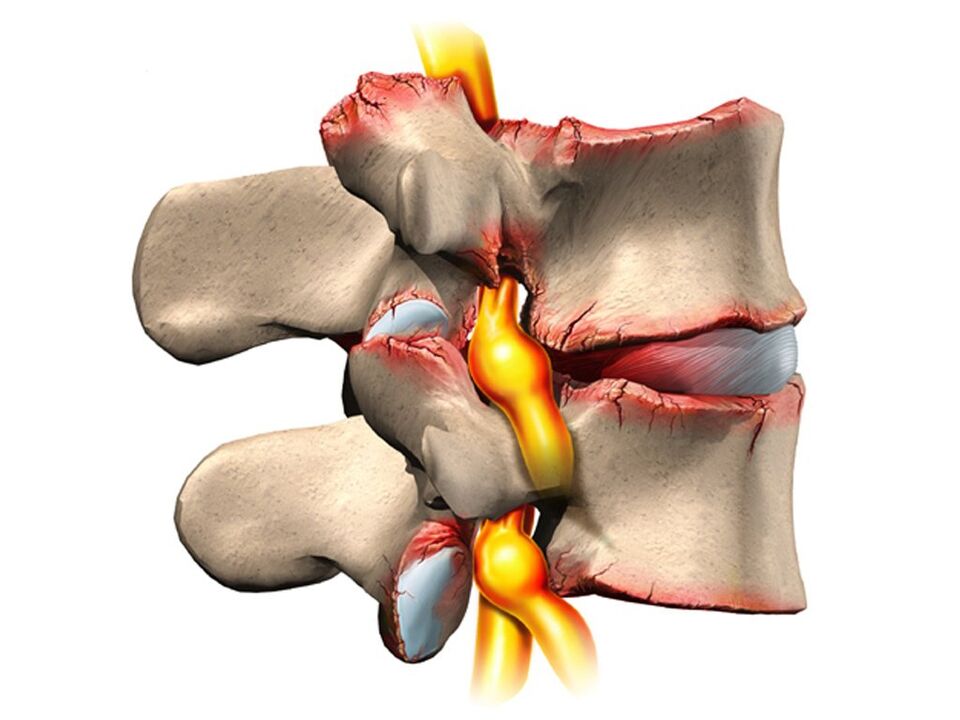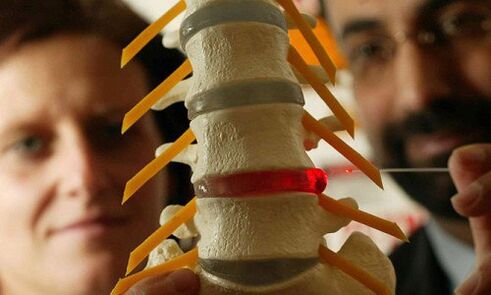
The term osteochondrosis itself comes from two words: osteo - bone, and chondrue - cartilage. In short, it is the ossification of cartilage. Although this interpretation is fundamentally wrong. Some in their delusion go further, and are convinced that osteochondrosis is the deposition of salt in the joints. Moreover, it is table salt that is supposedly consumed in large quantities for food.
Pathogenesis
In fact, it all happens a little differently. And harder. And table salt, if it plays any role in the occurrence of osteochondrosis, is very indirect. Osteochondrosis is based on degeneration and degeneration of articular cartilage. This is not an independent disease, but a pathological process that can be observed almost everywhere where there is connective cartilage tissue.
However, osteochondrosis in rare cases affects the spine. Why is that? The fact is that between the vertebrae there is a kind of pad - intervertebral disc (intervertebral). The physiological role of this disc is to protect and shield the vertebral body from premature wear due to mechanical stress. The disc consists of an internal fluid pulposus nucleus surrounded by a fibrous annulus and upper and lower end plates.
The disk experiences extraordinary mechanical stress, which leads to permanent damage to its structure at the cellular level. In humans, this process is all too obvious - this is our payment for walking upright. To prevent a disk from being "erased" completely, it must constantly regenerate, i. e. rebuild itself. It is the balance of the damage regeneration process that determines the normal structure of the intervertebral disc. Another curious detail is that the supply of blood and nutrients to the intervertebral disc is done not through blood vessels, which grow in childhood, but diffuse, from the bone tissue of the vertebral body. Again, payment for the ability to move on two limbs, not four.
Therefore, the intervertebral disc is easily injured in anatomical and physiological terms. Any negative process in the body leads to an imbalance in the damage-regeneration balance, and to the development of dystrophy and degeneration in the disc. Structurally damaged discs can no longer withstand proper mechanical stress. Under excessive pressure from the vertebrae above it, the disc is displaced in different directions, usually sideways and backwards. This process is called disc herniation.
The vertebral bone tissue, which has lost its cartilage layer, also suffers from mechanical wear. Due to constant trauma to the anterior edge surface of the vertebral body, pathological bone growth is formed - osteophytes. Spondylosis develops. Due to degeneration and displacement of the disc, the intervertebral space is reduced, the spinal canal narrows, and the spinal nerve roots in the so -called foraminal nerve are violated.
Cause
The causes, or etiological factors, of osteochondrosis are various. They can be both local, that is, due to the pathology of the spine itself, and general disorders at the level of the organism. Any pathology that leads to a violation of the structure of the spine or to metabolic disorders can be considered a cause of osteochondrosis. In this case, there are:
- Changes in spinal configuration (scoliosis, pathological lordosis or kyphosis).
- Other defects of the musculoskeletal system are flat feet, narrow shoulder girdle, anomalies in the structure of the pelvis.
- Spinal cord injuries.
- Weak immunity.
- Metabolic disorders - osteoporosis, obesity, diabetes mellitus, thyroid disease.
- Diseases of the cardiovascular system - atherosclerosis, hypertension.
- Digestive disorders leading to inadequate absorption of nutrients from the gastrointestinal tract.
- Descendants.
It should be noted that the above pathological conditions do not necessarily lead to osteochondrosis. This requires constant exposure to certain predisposing factors - hypothermia, malnutrition, an inactive lifestyle, or, conversely, excessive physical exercise.
symptoms
Osteochondrosis itself is an asymptomatic process. And, at the same time, the signs of intervertebral disc degeneration are varied. How is that? The fact is that the clinical manifestations of osteochondrosis are based on its complications - disc herniation, spondylosis, sciatica, narrowing of the spinal canal.
In addition, the clinic is highly variable depending on the primary localization of the process in the cervical, thoracic, or lumbosacral spine. The last part is most often affected, because the lower back is doing maximum physical activity. Signs of lumbosacral osteochondrosis:
- Pain (lumbodynia, lumbago, sciatica).
- Restriction of movement in the lower back and lower legs (intermittent claudication).
- Here, sensitivity disorders of the paresthesia type - numbness, burning, crawling.
- Pathological tension of the lumbar muscles.
- In the absence of treatment, pelvic organ dysfunction.
Cervical osteochondrosis is observed somewhat less frequently than lumbosacral. However, this pathology is also quite common. In addition to the typical signs of pain (cervicalgia), decreased sensitivity and movement in the upper legs, cervical osteochondrosis due to disruption of blood supply to the brain has its own characteristics. These features are shown:
- Insomnia.
- Headache.
- Periodic nausea.
- General weakness, rapid fatigue.
- Fluctuations in blood pressure.
- Occasional toothache.
- Behavioral reactions in the form of tears, irritation.
The thoracic area with osteochondrosis is affected relatively rarely. The patient in this case is a person who is forced to sit in a position uncomfortable by work - students, school students, programmers, office workers. The symptoms of osteochondrosis in this case are as follows:
- Pain and paresthesia in the chest.
- Dyspnea.
- Feeling of heartbeat.
- Restriction of movement in the thoracic spine.

Diagnostics
From all this it is clear that osteochondrosis is a chameleon disease. Due to the similarity of symptoms, it is easy to confuse with cerebrovascular accidents, hypertension, myocardial infarction, angina pectoris, neurotic disorders. That is why, to make a correct diagnosis, a comprehensive complex diagnosis is needed to properly determine the symptoms and treatment of osteochondrosis.
This diagnosis, in addition to traditional questions and clarification of patient complaints, should include medical examination and special research methods. These methods include x-rays of the spine, ultrasound of internal organs. Recently, computed magnetic resonance imaging has been successfully used to diagnose osteochondrosis.
Treatment
Therapeutic tactics for osteochondrosis involve the use of:
- Medications.
- massage.
- Physiotherapy procedures.
- Physiotherapy (exercise therapy).
- Manual therapy.
- Acupuncture.
Medications for osteochondrosis are primarily aimed at pain relief and elimination of inflammatory processes in the nerve roots. In various combinations, these drugs are widely used in the form of ointments, injections, tablets for the treatment of osteochondrosis. It should not be forgotten that these drugs have negative effects on the liver, stomach and intestines. With this, they can exacerbate metabolic disorders in osteochondrosis. They relieve blockage pain well with local anesthetics. True, the effect of these funds is short -term, and in no way affects the course of osteochondrosis as a whole.
It is possible to improve metabolic processes at the local level and the body with the help of drugs such as chondroprotectors, immunostimulants, and vitamins with minerals. Chondroprotectors are used in tablets, ointments, and ampoules. Among the strengthening agents, vitamin C, group B, in combination with minerals are used. In this case, calcium supplies are preferred. Indeed, contrary to some misconceptions, the basis of osteochondrosis is not excess, but simply a lack of calcium.
After successful relief of severity, physiotherapy procedures, massage, and exercise therapy are indicated. As a physical procedure, electrophoresis with calcium, phonophoresis with hydrocortisone, amplipulse, paraffin therapy were used. All of these measures are aimed at eliminating pain and inflammation in the nerve roots, ligaments and muscles. Massage for osteochondrosis is carried out according to generally accepted methods. The massage zone selected depends on the localization of the osteochondrosis. Expansion of range of motion is achieved with the help of exercise therapy. Initially, in the deterioration phase, there is almost no dynamic load. The patient is always in optimal posture. At this time, it is desirable to wear a crippling device - lumbar corset, neck collar Shants. As exacerbations decrease, the amount and duration of movement during exercise therapy increases.
Recently, in the treatment of osteochondrosis, non -traditional treatment methods have been accepted - acupuncture, manual therapy, osteopathy. Acupuncture is the effect on special biologically active points located along the spine, on the earlobes, on the hands and on the feet. With manual therapy, the normal position of the vertebrae and intervertebral discs is restored through the manual action of a specialist’s hands. And in the course of osteopathy, the structural integrity of the musculoskeletal system is ensured using certain techniques. If there is no effect of conservative measures for the treatment of osteochondrosis, persistent pain, complications, surgery is indicated. Pathologically displaced discs are removed. Currently, for this purpose, microdiscectomy is performed - the endoscopic removal of the transplanted disc.















































